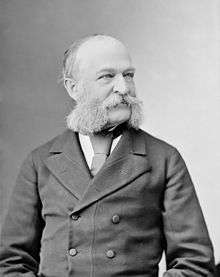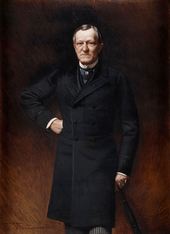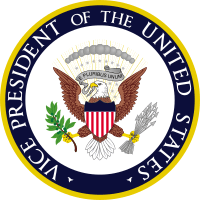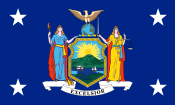Levi P. Morton
| Levi P. Morton | |
|---|---|
 | |
| 22nd Vice President of the United States | |
|
In office March 4, 1889 – March 4, 1893 | |
| President | Benjamin Harrison |
| Preceded by | Thomas A. Hendricks |
| Succeeded by | Adlai E. Stevenson |
| 31st Governor of New York | |
|
In office January 1, 1895 – December 31, 1896 | |
| Lieutenant | Charles T. Saxton |
| Preceded by | Roswell P. Flower |
| Succeeded by | Frank S. Black |
| United States Minister to France | |
|
In office March 21, 1881 – May 14, 1885 | |
| Appointed by | James A. Garfield |
| Preceded by | Edward Follansbee Noyes |
| Succeeded by | Robert Milligan McLane |
| Member of the U.S. House of Representatives from New York's 11th district | |
|
In office March 4, 1879 – March 21, 1881 | |
| Preceded by | Benjamin A. Willis |
| Succeeded by | Roswell P. Flower |
| Personal details | |
| Born |
Levi Parsons Morton May 16, 1824 Shoreham, Vermont, U.S. |
| Died |
May 16, 1920 (aged 96) Rhinebeck, New York, U.S. |
| Resting place | Rhinebeck Cemetery, Rhinebeck, New York |
| Nationality | American |
| Political party | Republican |
| Spouse(s) |
|
| Children | 7 |
| Signature |
 |
Levi Parsons Morton (May 16, 1824 – May 16, 1920) was the 22nd Vice President of the United States. He also served as United States Ambassador to France, as a Representative from New York, and as the 31st Governor of New York.
The son of a Congregational minister, Morton was born and educated in Vermont, and trained for a business career by clerking in stores and working in mercantile establishments in New Hampshire and Massachusetts. After relocating to New York City, Morton became a successful merchant, cotton broker, and investment banker.
Active in politics as a Republican, Morton was an ally of Roscoe Conkling. He was twice elected to the United States House of Representatives, and he served one full term, and one partial one (March 4, 1879 – March 21, 1881). In 1880, Republican presidential nominee James A. Garfield offered Morton the vice presidential nomination in an effort to win over Conkling loyalists who were disappointed that their choice for president, Ulysses S. Grant, had lost to Garfield. Conkling advised Morton to decline, which he did. Garfield then offered the nomination to another Conkling ally, Chester A. Arthur, who accepted.
After Garfield and Arthur were elected, Garfield nominated Morton to be Minister Plenipotentiary to France, and Morton served in Paris until 1885. In 1888, Morton was nominated for vice president on the Republican ticket with presidential nominee Benjamin Harrison; they were elected, and Morton served as Vice President from 1889 to 1893. In 1894, Morton was the successful Republican nominee for Governor of New York, and he served one term, 1895 to 1896.
In retirement, Morton resided in New York City and Rhinebeck, New York. He died in 1920, and was buried at Rhinebeck Cemetery.
Early life
Morton was born in Shoreham, Vermont. His parents were the Reverend Daniel Oliver Morton (1788–1852), a Congregational minister and Lucretia Parsons (1789–1862). His older brother, Daniel O. Morton (1815–59), was Mayor of Toledo, Ohio from 1849 to 1850.[1]
Morton's family moved to Springfield, Vermont in 1832 when his father became the minister of the Congregational church there. Rev. Morton headed the congregation during the construction of the brick colonial revival style church on Main Street that is still in use today. Levi P. Morton was considered by his Springfield peers to be a "leader in all affairs in which schoolboys usually engage." The family moved away when Rev. Morton was reassigned in 1836.[2]
Morton attended the public schools of Vermont and Shoreham Academy. He decided on a business career, and worked as a general store clerk in Enfield, Massachusetts. Morton also taught school in Boscawen, New Hampshire, engaged in mercantile pursuits in Hanover, New Hampshire, and moved to Boston to work in the Beebe & Co. importing business. He eventually settled in New York City, where he entered the dry goods business, became a successful cotton broker, and established himself as one of the country's top investment bankers in a firm he founded, Morton, Bliss & Co. He was an unsuccessful candidate for election in 1876 to the 45th Congress, and was appointed by President Rutherford B. Hayes to be an honorary commissioner to the Paris Exhibition of 1878.
Political career
Member of Congress
Morton was elected, as a Republican, to the 46th and 47th Congresses representing Manhattan. He served from March 4, 1879, until his resignation, effective March 21, 1881. The 1880 Republican presidential nominee, James A. Garfield, asked Morton to be his vice presidential running mate, attempting to win over disappointed supporters of Ulysses S. Grant's candidacy for a third term. Morton was loyal to Senator Roscoe Conkling, who was Grant's campaign manager; unhappy that Grant had not been nominated, Conkling advised Morton to decline; Morton followed Conkling's advice. Garfield's supporters then turned to Chester A. Arthur, another Conkling supporter. Conkling advised Arthur to decline, but Arthur accepted; Garfield and he were narrowly elected over their Democratic opponents.
Minister to France
After Garfield's election, Morton asked to be appointed United States ambassador to either the United Kingdom or France. He was U.S. Minister Plenipotentiary to France from 1881 to 1885. (A deluded Charles J. Guiteau reportedly decided to murder Garfield after he was "passed over" as minister to France.)
Morton was very popular in France. He helped commercial relations between the two countries run smoothly during his term, and, in Paris on October 24, 1881, he placed the first rivet in the construction of the Statue of Liberty. (It was driven into the big toe of Lady Liberty's left foot.) After completion of the statue, he accepted Liberty on behalf of the United States in a ceremony on July 4, 1884 by signing the Union Franco Americaine contract with that date.
Vice President
Morton was elected Vice President of the United States, on the Republican ticket with President Benjamin Harrison, in which capacity he served from March 4, 1889, to March 4, 1893. During his term, Harrison tried to pass the Lodge Bill, an election law enforcing the voting rights of blacks in the South; the billed failed because Morton did little in his role as the Senate's presiding officer to support the bill against a Democratic filibuster.[3] Harrison blamed Morton for the bill's eventual failure, and, at the Republican convention prior to the 1892 election, Morton decided not to run for a second term and was replaced by Whitelaw Reid as the vice-presidential candidate.[4] Harrison and Reid went on to lose the 1892 election, to Grover Cleveland and Adlai E. Stevenson, the Democratic candidates.
Governor of New York

Levi Morton was Governor of New York in 1895 and 1896. He was considered for the Republican presidential nomination in 1896, but the Republican Party chose William McKinley instead. After his public career was over, he became a real estate investor.
Marriages and personal life
Morton married his first wife, Lucy Young Kimball (July 22, 1836 – July 11, 1871) on October 15, 1856, in Flatlands, Brooklyn. They had one child, a daughter who died in infancy, in 1857.
His first wife died in 1871, and in 1873 Morton married Anna Livingston Reade Street. She was Second Lady of the United States during her husband's vice–presidency, and often handled entertaining duties for the administration due to First Lady Caroline Harrison's ill health. She had five daughters with Morton, and a son who died in infancy.
In 1890 he became one of the first members of the District of Columbia Society of the Sons of the American Revolution. He was assigned national society membership number 1838 and district society number 38.[5] He was also a member of the General Society of Colonial Wars.
In retirement, he served as President of the Metropolitan Club at One East Sixtieth Street, New York, between 1900 and 1911. He was preceded in that office by J. Pierpont Morgan; and succeeded by Frank Knight Sturgis.[6] He was also a member of the Union League Club of New York, and served as President of the New York Zoological Society from 1897 to 1909.
Death
Morton became ill during the winter of 1919–1920; a cold developed into bronchitis, and Morton eventually contracted pneumonia, which proved fatal.[7] He died in Rhinebeck, New York on May 16, 1920.[8] His death occurred on his 96th birthday, making him the only Vice President to have died on his birthday. He is interred at Rhinebeck Cemetery.[9]
Morton was the second longest-lived Vice President of the United States. Only Franklin D. Roosevelt's first Vice President, John Nance Garner (who died 15 days before his 99th birthday), lived longer. Morton survived five of his successors in the vice presidency: Adlai E. Stevenson, Garret Hobart, Theodore Roosevelt, Charles W. Fairbanks, and James S. Sherman.
Legacy
The Village of Morton Grove, Illinois, is named after Morton. He provided the funding necessary to allow Miller's Mill (now Lincoln Avenue) to pass through the upstart neighborhood, and provide goods to trade and sell. Morton Grove was incorporated in December 1895.
Morton owned property in Newport, Rhode Island, spending his summers on Bellevue Avenue in his mansion called "Fairlawn", built 1852-1853, which is currently owned by Salve Regina University, housing the Pell Center of International Relations and Public Policy. He left a nearby property to the city of Newport for use as a park. The park is at the corner of Coggeshall and Morton avenues (the latter formerly Brenton Road), and is named Morton Park.
Morton sold or donated property he owned in Hanover, New Hampshire, to Dartmouth College, and the college built Webster Hall on the land. Morton was considered an honorary alumnus at alumni gatherings in New York. He also owned a summer retreat in the Adirondack Park, on Eagle Island.[10] The architecture is of the Great Camps style, designed by the notable architect William L. Coulter. Over the years, the island found its way into the ownership of the Girl Scouts of the USA, where it remains today as Camp Eagle Island.[11]
See also
- Place des États-Unis, Paris, France
References
- ↑ "Partial Genealogy of the Mortons of New York, Plymouth, and Ohio" (PDF).
- ↑ Hubbard, Charles Horace (1895). History of the Town of Springfield, Vermont. G.H. Walker & Co. pp. 40, 75, 236.
- ↑ "Levi Parsons Morton, 22nd Vice President (1889-1893)". Senate Historical Office. Washington, DC: Historian of the United States Senate. Retrieved December 19, 2016.
- ↑ "Vice Presidents of the United States, 1789-1993" (PDF). United States Senate Historical Office. 1997. Retrieved 2008-10-25.
- ↑ Sons of the American Revolution Application, Levi P. Morton, accessed via Ancestry.com
- ↑ Club Members of New York. New York, NY: Club Members of New York, Inc. 1940. p. 136.
Seven presidents have presided over the club: J. Pierpont Morgan, L. P. Morton, F. K. Sturgis...
- ↑ "Levi P. Morton is Dead on his 96th Birthday". The Sun and the New York Herald. New York, NY. May 17, 1920. p. 1. (Subscription required (help)).
- ↑ "Morton A Resident Of Washington. Only Part of His Estate Will Be Taxable in This State. But Suit Will Be Brought. Test Was Attempted In the Case of Mrs. Morton, but Never Reached Conclusion" (PDF). New York Times. May 18, 1920. Retrieved 2015-05-16.
The estate of ex-Governor Levi P. Morton will probably Day to the State of New York only the inheritance tax due from the estate of a non-resident, as Mr. Morton had made Washington, D.C., his residence for ten years.
- ↑ "Many Notables to Attend Funeral of Levi P. Morton". Poughkeepsie Eagle-News. Poughkeepsie, NY. May 18, 1920. p. 1. (Subscription required (help)).
- ↑ "National Historic Landmark Nomination, Eagle Island Camp" (PDF). www.nps.gov. National Park Service. August 18, 2004. p. 13.
- ↑ ""National Historic Landmark Nomination, Eagle Island Camp"" (PDF).
External links
| Wikimedia Commons has media related to Levi Morton. |
| Wikisource has the text of a 1911 Encyclopædia Britannica article about Levi P. Morton. |
- United States Congress. "Levi P. Morton (id: M001018)". Biographical Directory of the United States Congress.
- Levi P. Morton birthplace
- Levi P. Morton at Find a Grave
- Ancestors of Levi Parsons Morton
| U.S. House of Representatives | ||
|---|---|---|
| Preceded by Benjamin A. Willis |
Member of the U.S. House of Representatives from New York's 11th congressional district 1879–1881 |
Succeeded by Roswell P. Flower |
| Diplomatic posts | ||
| Preceded by Edward Noyes |
United States Minister to France 1881–1885 |
Succeeded by Robert Milligan McLane |
| Party political offices | ||
| Preceded by John A. Logan |
Republican nominee for Vice President of the United States 1888 |
Succeeded by Whitelaw Reid |
| Preceded by Sloat Fassett |
Republican nominee for Governor of New York 1894 |
Succeeded by Frank S. Black |
| Political offices | ||
| Preceded by Thomas A. Hendricks |
Vice President of the United States 1889–1893 |
Succeeded by Adlai Stevenson |
| Preceded by Roswell P. Flower |
Governor of New York 1895–1896 |
Succeeded by Frank S. Black |

